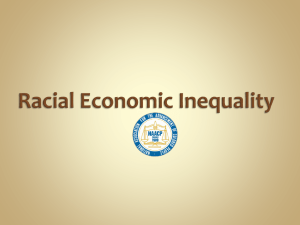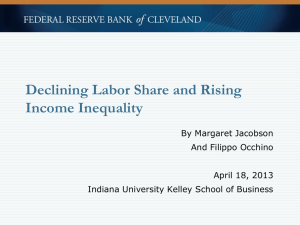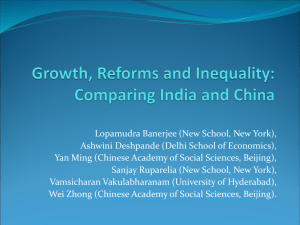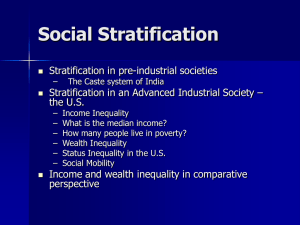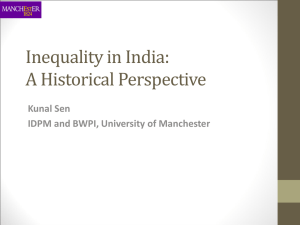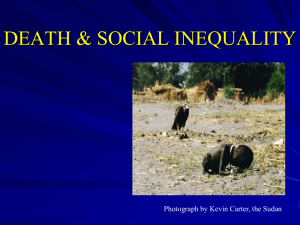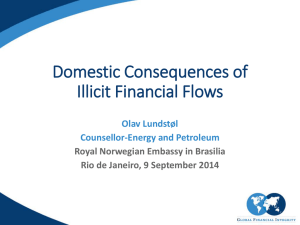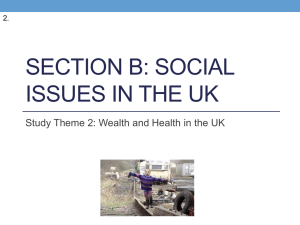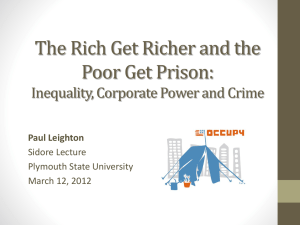Gini ratio
advertisement
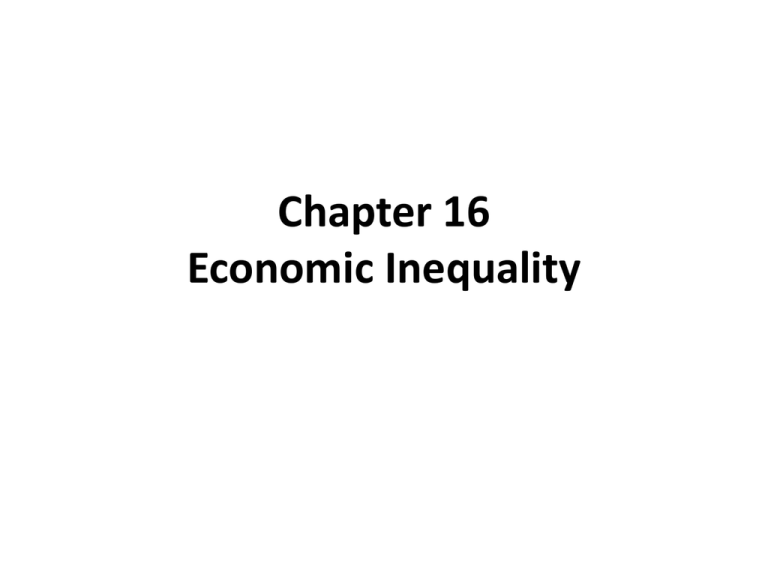
Chapter 16 Economic Inequality Economic Inequality in the United States •Money income equals market income plus cash payments to households by the government. •Market income = wages, interest, rent, and profit earned by the household in factor markets, before paying income taxes. Economic Inequality in the United States •The Distribution of Income •Figure 19.1 shows the distribution of income across the 117.5 million households in the United States in 2009. Economic Inequality in the United States •The mode income is the most common income and was about $22,000. •The median income is the level of income that separates the population into two groups of equal size and was $49,777. •The mean income is the average income and was $67,976. Economic Inequality in the United States •A distribution in which the mean exceeds the median and the median exceeds the mode is positively skewed, which means it has a long tail of high values. •The U.S. distribution of income is positively skewed. Economic Inequality in the United States A common way to summarize income inequality is the quintile (by fifths) distribution of income •Figure 19.2 shows the distribution of income shares for the United States in 2009. Economic Inequality in the United States In 2009: •The poorest 20% of households received only 3.4% of the total income. •The middle 20% received 14.6% of total income. •The richest 20% received 50.2% of total income. Economic Inequality in the United States •The Income Lorenz Curve •The income Lorenz curve graphs the cumulative percentage of income earned against the cumulative percentage of households. Economic Inequality in the United States •The vertical axis plots the cumulative percentage of income. •The horizontal axis is the cumulative percentage of households. Economic Inequality in the United States •If everyone has the same income, the income Lorenz curve is a 45 degree line from the lower left corner to the upper right corner. •This line is called the line of equality. •The Lorenz curve shows the distribution of income. Economic Inequality in the United States •The Distribution of Wealth •A household’s wealth is the value of all the things that it owns at a point in time. •The distribution of wealth is another way of examining the degree of economic inequality. Economic Inequality in the United States •A wealth Lorenz curve measures the distribution of wealth. •The distribution of wealth is even more unequally distributed than income. Economic Inequality in the United States •Wealth or Income? –Wealth is a stock of assets at a point in time. –Income is a flow of earnings over a period of time . –Because the distribution of wealth excludes human capital, the distribution of income is a more accurate measure of economic inequality. Economic Inequality in the United States •Trends in Inequality Gini ratio = the ratio of blue area to the red area in the two figures below. Economic Inequality in the United States •With perfect equality, the Lorenz curve is the line of equality and the Gini ratio is zero. Economic Inequality in the United States •With the most extreme inequality—one person has all the income—the Lorenz curve runs along the axes and the Gini ratio is one. Economic Inequality in the United States •The closer the Gini ratio is to one, the more unequal is the distribution of income. •In 2009, the U.S. Gini ratio was a bit more than 0.46. Economic Inequality in the United States •Figure 19.5 shows the U.S. Gini ratio from 1970 to 2009. •The Gini ratio shows that the distribution of income in the United States has become more unequal. •Despite the change in the definition in 1992, the trend is still visible. Inequality in the World Economy •Figure 19.6 illustrates some extremes and the U.S. Lorenz curves. Inequality in the World Economy Global Inequality and Its Trends •The global distribution of income is much more unequal than the distribution within any one country. •Of the world population: –50 percent live on $2.50 a day or less; 30 percent live on between $2.50 and $10 a day. –That is, 80 percent of the world population is very poor. –The average American has $115 a day. Inequality in the World Economy World Gini Ratio •The global distribution of income is becoming less unequal. •Despite individual countries are becoming more unequal, incomes in poorer countries are rising faster than incomes in rich countries. What caused economics inequality? • No one actually distributes income in our society • The distribution of income is the product of supply of and demand for productive services • An activity is productive if it enables people to obtain something for which they’re willing to pay What caused economics inequality? • The income that resource owners can receive is created by the demand for the services of those resources. • Resources are scarce, but scarcity is not the same as rarity. • “People become wealthy by satisfying others’ demand.” What caused economics inequality? • Income distribution depends fundamentally on the ownership of productive resources • “The distribution of income depends on the prior distribution of wealth” • The production of productive resources is investment. Wealthy people have more opportunities to invest, which generate more income Matthew Effect “For whoever has will be given more, and they will have an abundance. Whoever does not have, even what they have will be taken from them.” —Matthew 25:29 The phenomenon where "the rich get richer and the poor get poorer". “Assortative mating” makes wealth more concentrated. Winner-Take-All Markets Small differences in performance give rise to enormous differences in reward. Outcome: Important professions like teaching and engineering in aching need of more talent. What can we do? • Human capital is an important component of wealth • The most readily portable form of wealth • Explains why propsering ethnic minorities often obtained high levels of education • Increased demand for more highly skilled and more extensively schooled workers imply the importance of human capital How to become rich? 1. Satisfy other people’s demand 2. Invest in human capital Income Redistribution Three main ways: 1. Progressive Income taxes 2. Income maintenance programs – Social Security programs – Unemployment compensation – Welfare programs 3. Subsidized services – Health care, education Income Redistribution -- The Big Tradeoff • Big tradeoff between equity and efficiency • Three reasons for inefficiency: 1. Resources are used that could have otherwise been used for producing goods and services. 2. Taxes generate a deadweight loss. 3. Decreases the incentives for taxpaying workers to provide labor
